Flexural Behavior of Continuous Beams Made of Self-Compacting Concrete (SCC)—Experimental and Numerical Analysis
Abstract
1. Introduction
2. Experimental Program
2.1. Applied Materials and Mixture Proportioning
2.2. Examination of the SCC Characteristics
2.3. Test Procedure and Instrumentation
3. Results and Discussion
3.1. Analysis of Results of Recorded Deflections
3.2. Analysis of Dilatations in the Middle of the Beams Span and above the Middle Support
3.3. Analysis of Formation, Propagation and Width of Cracks
4. Numerical Analysis
4.1. Model Geometry, Material Models and Finite Element Mesh
- Dilation angle ψ (10° ≤ ψ ≤ 40°), whereby the adopted value in the paper is ψ = 35°. The analyses indicated that satisfactory results are obtained when the dilation angle is between 30° and 40°, as well as the differences are minimal for the different values of dilation angle in the mentioned range [43,45];
- ratio of the magnitude of deviation stress in tension and compression K, whereby the adopted value in the paper is K = 0.666 (default value). It was confirmed that the default value provides satisfactory results [43,45]. In [43] the impact of this parameter was analyzed and it was demonstrated that its impact on the results is small, and that a higher K provides a stiffer model;
- viscosity parameter μ, which is implemented for the purpose of achieving a solution convergence, whereby the adopted value in the paper is μ = 0.0002. This parameter should be around 15% of the time increment [43].
4.2. Boundary Conditions and Load
4.3. Comparative Analysis of the Results
5. Conclusions
- Continuous beams made of SCC have a satisfactory load-bearing capacity and stiffness.
- The examined different percentages of reinforcement show that with the increase of the percentage of reinforcement, the bearing capacity of the beams also increases (ultimate load is 166 kN, 193 kN and 197 kN for 0.65%, 0.86% and 0.94% of reinforcement, respectively).
- As the percentage of reinforcement increases, the width and distribution of cracks in the tensioned part of the concrete decreases.
- Increasing the percentage of reinforcement has a negative effect, which is reflected in the fact that an excessive percentage of reinforcement leads to a more brittle failure of the beam, while the failure of the beam with a lower percentage of reinforcement is more ductile. In the case of 0.65% and 0.86% of reinforcement after the yield of tensioned reinforcement, deflections increase significantly with prominent propagation of cracks, which is characteristic of ductile failure. On the other hand, in the case of 0.94% of reinforcement after the yield of tensioned reinforcement, deflections increase slightly with crushing of compressed concrete, which is characteristic of brittle failure. This should be especially taken into account when designing beams in seismically active areas when one should tend to form plastic joints at the ends of beams, while avoiding heavily reinforced sections.
- The proposed numerical model is validated and verified with experimentally obtained results. The numerically calculated ultimate load differs less than 5% compared to the experimentally measured values, which can be accepted as a good agreement of the numerical and experimental results. The proposed numerical model is simple to implement and does not require large computer resources, and can be applied in further research in this area, while costly and demanding experimental tests can be avoided.
- The proposed numerical model cannot fully include crack emergence and stress redistribution from concrete to reinforcement in the crack zone. In the case of such analyses, it is necessary to apply material models of failure mechanics.
Author Contributions
Funding
Conflicts of Interest
References
- Okamura, H.; Ozawa, K. Mix Design for Self-Compacting Concrete, Concrete. Libr. Jpn. Soc. Civ. Eng. 1995, 25, 107–120. [Google Scholar]
- Okamura, H.; Ouchi, M. Self-Compacting Concrete. J. Adv. Concr. Technol. 2003, 5, 5–15. [Google Scholar] [CrossRef]
- Oucho, M.; Nakamura, S.; Osterberg, T.; Hallberg, S.-E.; Lwin, M. Applications of Self-Compacting Concrete in Japan, Europe and the United States; Transportation Research Board: Washington, DC, USA, 2003; p. 20. [Google Scholar]
- Brouwers, H.J.H.; Radix, H.J. Self-Compacting Concrete: Theoretical and experimental study. Cem. Concr. Res. 2005, 35, 2116–2136. [Google Scholar] [CrossRef]
- Su, N.; Hsu, K.-C.; Chai, H.-W. A simple mix design method for self-compacting concrete. Cem. Concr. Res. 2001, 31, 1799–1807. [Google Scholar] [CrossRef]
- Aggarwal, P.; Siddique, R.; Aggarwal, Y.; Gupta, S.M. Self-Compacting Concrete-Procedure for Mix Design. Leonardo Electron. J. Pract. Technol. 2008, 12, 15–24. [Google Scholar]
- Shi, C.; Wu, Z.; Wu, K.L.L. A review on mixture design methods for self-compacting concrete. Constr. Build. Mater. 2015, 84, 387–398. [Google Scholar] [CrossRef]
- Nanthagopalan, P.; Santhanam, M. Fresh and hardened properties of self-compacting concrete produced with manufactured sand. Cem. Concr. Compos. 2011, 33, 353–358. [Google Scholar] [CrossRef]
- Felekoglu, B.; Turkel, S.; Baradan, B. Effect of water/cement ratio on the fresh and hardened properties of self-compacting concrete. Build. Environ. 2007, 42, 1795–1802. [Google Scholar] [CrossRef]
- Persson, B. A comparison between mechanical properties of self-compacting concrete and the corresponding properties of normal concrete. Cem. Concr. Res. 2001, 31, 193–198. [Google Scholar] [CrossRef]
- Domone, P.L. A review of the hardened mechanical properties of self-compacting concrete. Cem. Concr. Compos. 2007, 29, 1–12. [Google Scholar] [CrossRef]
- Vilanova, A.; Fernandez-Gomez, J.; Landsberge, A.G. Evaluation of the mechanical properties of self compacting concrete using current estimating models Estimating the modulus of elasticity, tensile strength, and modulus of rupture of self compacting concrete. Constr. Build. Mater. 2011, 25, 3417–3426. [Google Scholar] [CrossRef]
- Aslani, F.; Nejadi, S. Mechanical properties of conventional and self-compacting concrete: An analytical study. Constr. Build. Mater. 2012, 36, 330–347. [Google Scholar] [CrossRef]
- EFNARC. Specification and Guidelines for Self-Compacting Concrete; EFNARC: Farnham, UK, 2002; p. 32. [Google Scholar]
- EFNARC. The European Guidelines for Self-Compacting Concrete Specification; Production and Use; EFNARC: Farnham, UK, 2005; p. 66. [Google Scholar]
- Liu, X.-J.; Yu, Z.-W.; Jiang, L.-Z. Long term behavior of self-compacting reinforced concrete beams. J. Cent. South Univ. Technol. 2008, 15, 423–428. [Google Scholar] [CrossRef]
- Kumar, R.; Kumar, R.; Kumar, N. In Situ Performance of Self-Compacting Concrete in T-Beams. J. Mater. Civ. Eng. 2009, 21, 103–109. [Google Scholar] [CrossRef]
- Hassan, A.A.A.; Hossain, K.M.A.; Kachemi, M. Strength, cracking and deflection performance of large-scale self-conolidating concrete beams subjected to shear failure. Eng. Struct. 2010, 32, 1262–1271. [Google Scholar] [CrossRef]
- Sharifi, Y. Structural Performance of Self-consolidating Concrete Used in Reinforced Concrete Beams. KSCE J. Civ. Eng. 2012, 16, 618–626. [Google Scholar] [CrossRef]
- Cattaneo, S.; Giussani, F.; Mola, F. Flexural behaviour of reinforced, prestressed and composite self-consolidating concrete beams. Constr. Build. Mater. 2012, 36, 826–837. [Google Scholar] [CrossRef]
- Vidivelli, B.; Kathiravan, T.; Gobi, T. Flexural Behaviour of Self Compacting and Self Curing Concrete Beams. Asian Rev. Civ. Eng. 2013, 2, 1–9. [Google Scholar]
- Helincks, P.; Boel, V.; Corte, W.; Schutter, G.; Desnerck, P. Structural behaviour of powder-type self-compacting concrete: Bond performance and shear capacity. Eng. Struct. 2013, 48, 121–132. [Google Scholar] [CrossRef]
- Korte, S.; Boel, V.; Corte, W.; Schutter, G. Behaviour of fatigue loaded self-compacting concrete compared to vibrated concrete. Struct. Concr. 2014, 15, 575–589. [Google Scholar] [CrossRef]
- Biolzi, L.; Cattaneo, S.; Mola, F. Bending-shear response of self-consolidating and high-performance reinforced concrete beams. Eng. Struct. 2014, 59, 399–410. [Google Scholar] [CrossRef]
- Aderhya, S.V.; Vennila, A.; Venkatasubramani, R.; Vidya, S.V. Flexural Behaviour of Reinforced Beam using Self-compacting Concrete. Int. J. Earth Sci. Eng. 2016, 9, 533–548. [Google Scholar]
- Dharmaraj, R.; Malathy, R. Flexural behaviour of reinforced self compacting concrete containing corrosion inhibitors. Int. J. Adv. Eng. Technol. 2016, 8, 532–535. [Google Scholar]
- Khatab, T.A.M.; Ashour, F.A.; Sheehan, T.; Lam, D. Experimental investigation on continuous reinforced SCC deep beams and Comparisons with Code provisions and models. Eng. Struct. 2017, 131, 264–274. [Google Scholar] [CrossRef]
- Gohar, S.; Afefy, M.H.; Kassem, M.N.; Taher FEl-Din, S. Flexural performance of self-compacting concrete beams under repeated loading. J. Eng. Struct. 2017, 143, 441–454. [Google Scholar] [CrossRef]
- Imran Sharik, M.; Joshua Daniel, A. To study the flexural behaviour of non-prismatic beams using self compacting concrete. Pak. J. Biotechnol. 2017, 14, 377–381. [Google Scholar]
- Yaw, L.T.; Osei, J.B.; Adom-Asamoah, M. On The Non-Linear Finite Element Modelling of Self-Compacting Concrete Beams. J. Struct. Transp. Stud. 2017, 2, 1–18. [Google Scholar]
- Dolatabad, Y.A.; Maghsoudi, A.L. Ultimate stress increase in unbonded tendons in post-tensioned indeterminate I-beams cast with high strength normal and self compacting concrete. Eng. Sci. Technol. Int. J. 2018, 21, 495–506. [Google Scholar] [CrossRef]
- Akinpelu, M.A.; Adedeji, A.A. Structural Response of Reinforced Self-Compacting Concrete Deep Beam using Finite Element Method. J. Soft Comput. Civ. Eng. 2018, 2, 36–61. [Google Scholar]
- Mabrouk, T.S.; Rasha, M.A. Behavior of RC beams with tension lap splices confined with transverse reinforcement using different types of concrete under pure bending. Alex. Eng. J. 2018, 57, 1727–1740. [Google Scholar] [CrossRef]
- Grdic, Z.; Toplicic-Curcic, G.; Despotovic, I.; Ristic, N. Properties of self-compacting concrete prepared with coarse recycled concrete aggregate. Constr. Build. Mater. 2010, 24, 1129. [Google Scholar] [CrossRef]
- Milošević, B. Experimental-Theoretical Analysis of Limit States of Linear Beams Made of Self-Compacting Concrete with Recycled Aggregate. Ph.D. Thesis, University of Niš, Niš, Serbia, 2016. [Google Scholar]
- EN 206-9:2010. Additional Rules for Self-Compacting Concrete (SCC); European Commitee for Standardization: Brussels, Belgium, 2010; p. 27. [Google Scholar]
- Eurocode 2: Design of Concrete Structures—Part 1-1: General Rules and Rules for Buildings; European Commitee for Standardization: Brussels, Belgium, 2004.
- Askarinejad, S.; Rahbar, N. Effects of cement-polymer interface properties on mechanical response of fiber-reinforced cement composites. J. Nanomech. Micromech. 2017, 7, 04017002. [Google Scholar] [CrossRef]
- Ranković, S.; Folić, R.; Mijalković, M. Behavior at bending stress of reinforced concrete beams reinforced by NSM method with CFRP and GFRP bars-theoretical and experimental studies. Rom. J. Mater. 2013, 43, 4. [Google Scholar]
- Wang, T.; Hsu, T.T.C. Nonlinear finite element analysis of concrete structures using new constitutive models. Comput. Struct. 2001, 79, 2781–2791. [Google Scholar] [CrossRef]
- Hibbitt, D.; Karlsson, B.; Sorensen, P. Abaqus Analysis User’s Guide; Dassault Systemes: Vélizy-Villacoublay, France, 2013. [Google Scholar]
- Alfarah, B.; López-Almansa, F.; Oller, S. New Methodology for Calculating Damage Variables Evolution in Plastic Damage Model for RC Structures. Eng. Struct. 2017, 132, 70–86. [Google Scholar] [CrossRef]
- Genikomsou, S.A.; Polak, A.M. Finite Element Analysis of Punching Shear of Concrete Slabs Using Damaged Plasticity Model in ABAQUS. Eng. Struct. 2015, 98, 38–48. [Google Scholar] [CrossRef]
- Earij, A.; Alfano, G.; Cashell, K.; Zhou, X. Nonlinear three-dimensional finite-element modelling of reinforced-concrete beams: Computational challenges and experimental validation. Eng. Fail. Anal. 2017, 82, 92–115. [Google Scholar] [CrossRef]
- Eriksson, D.; Gasch, T. FEM-Modeling of Reinforced Concrete and Verification of the Concrete Material Models Available in ABAQUS; Royal Institute of Technology, Department of Mechanics: Stockholm, Sweden, 2010. [Google Scholar]

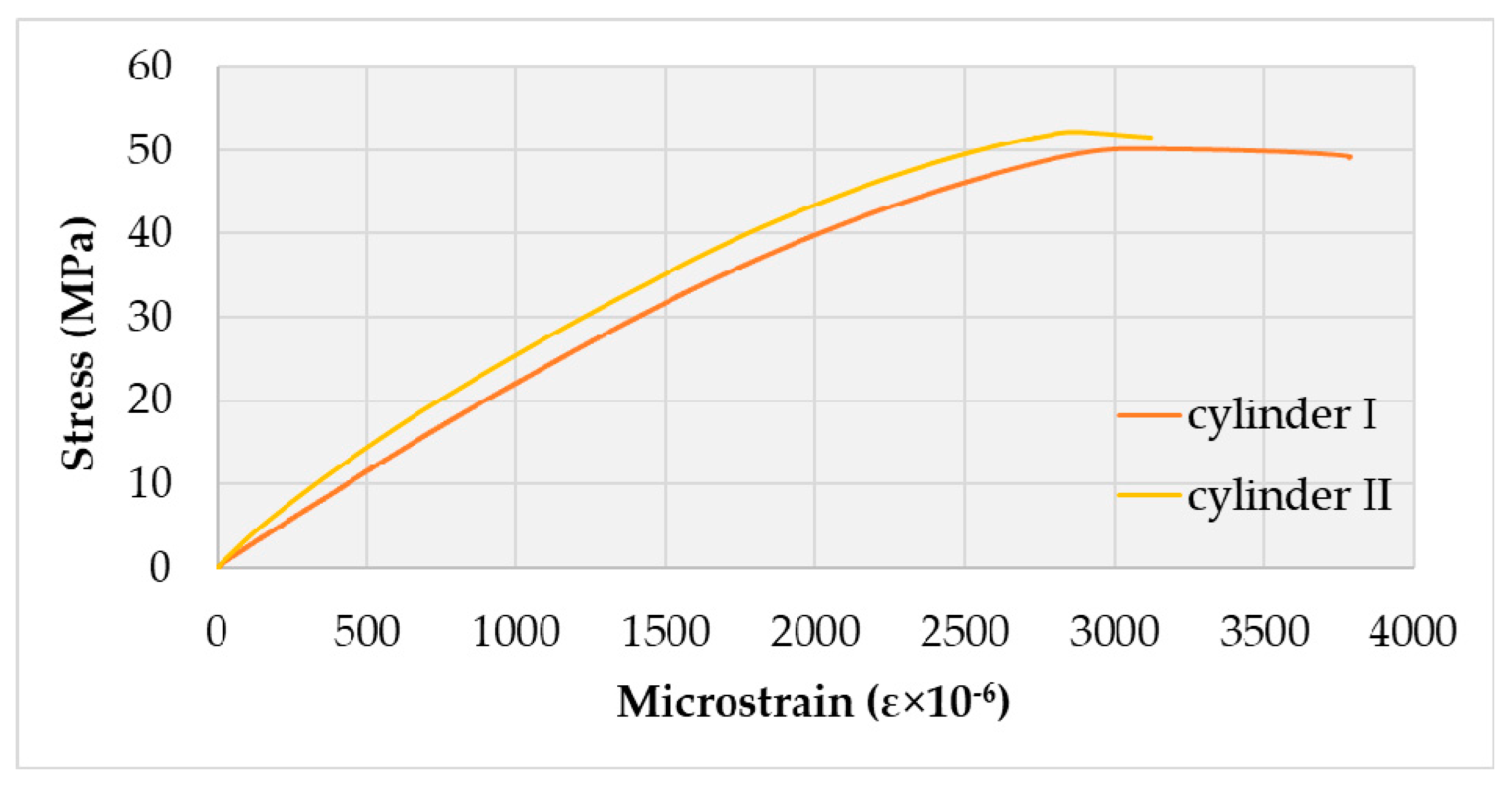
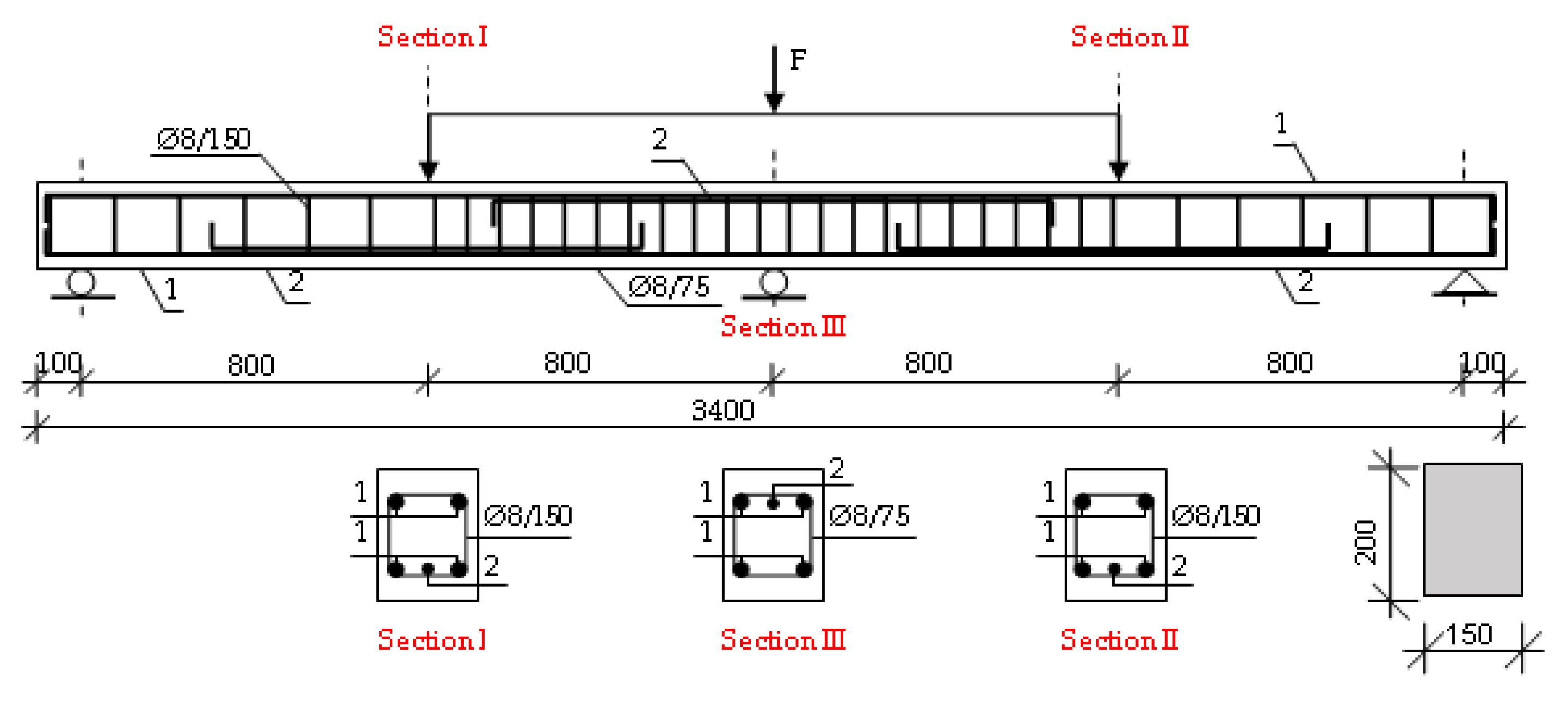
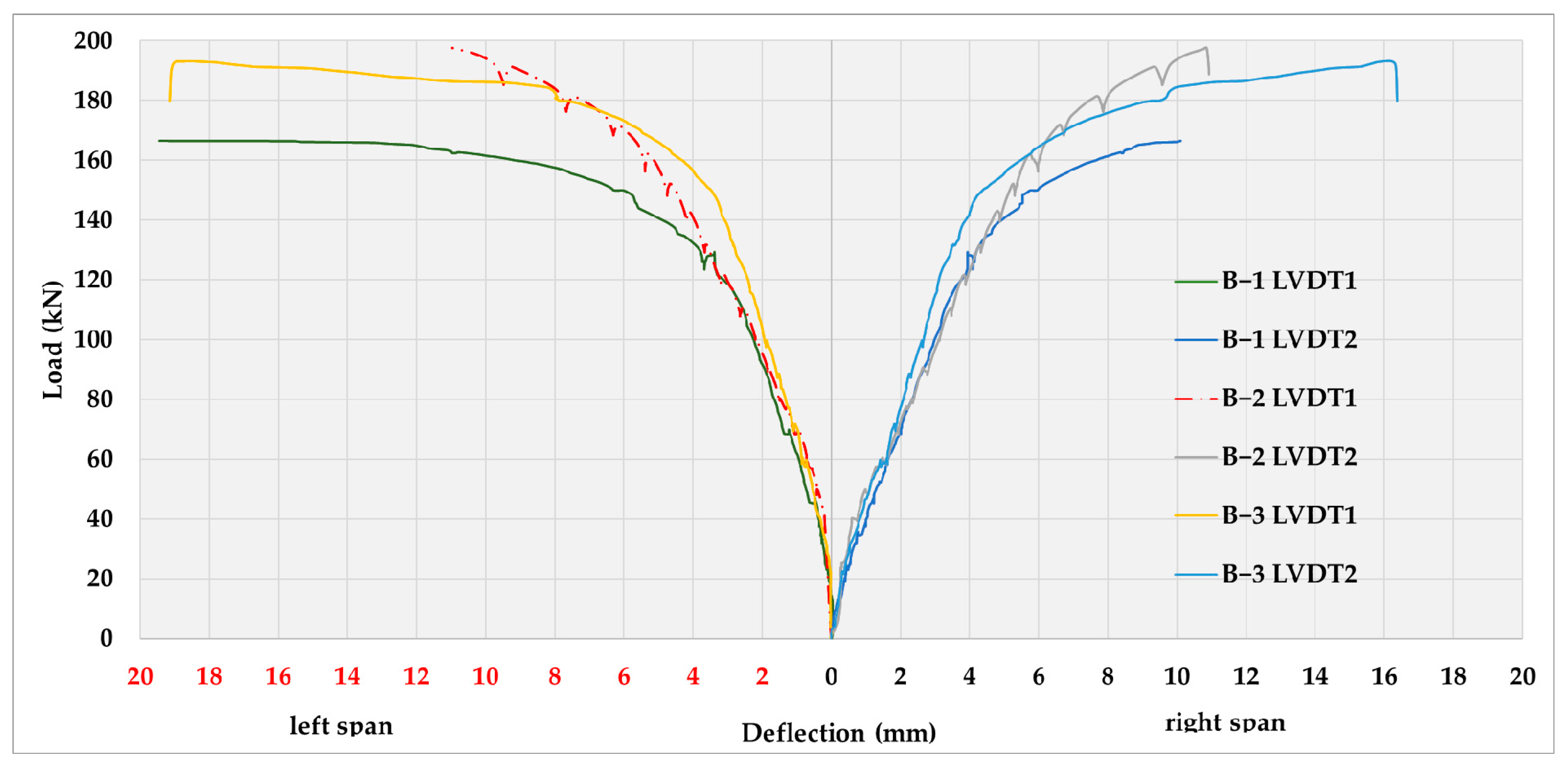
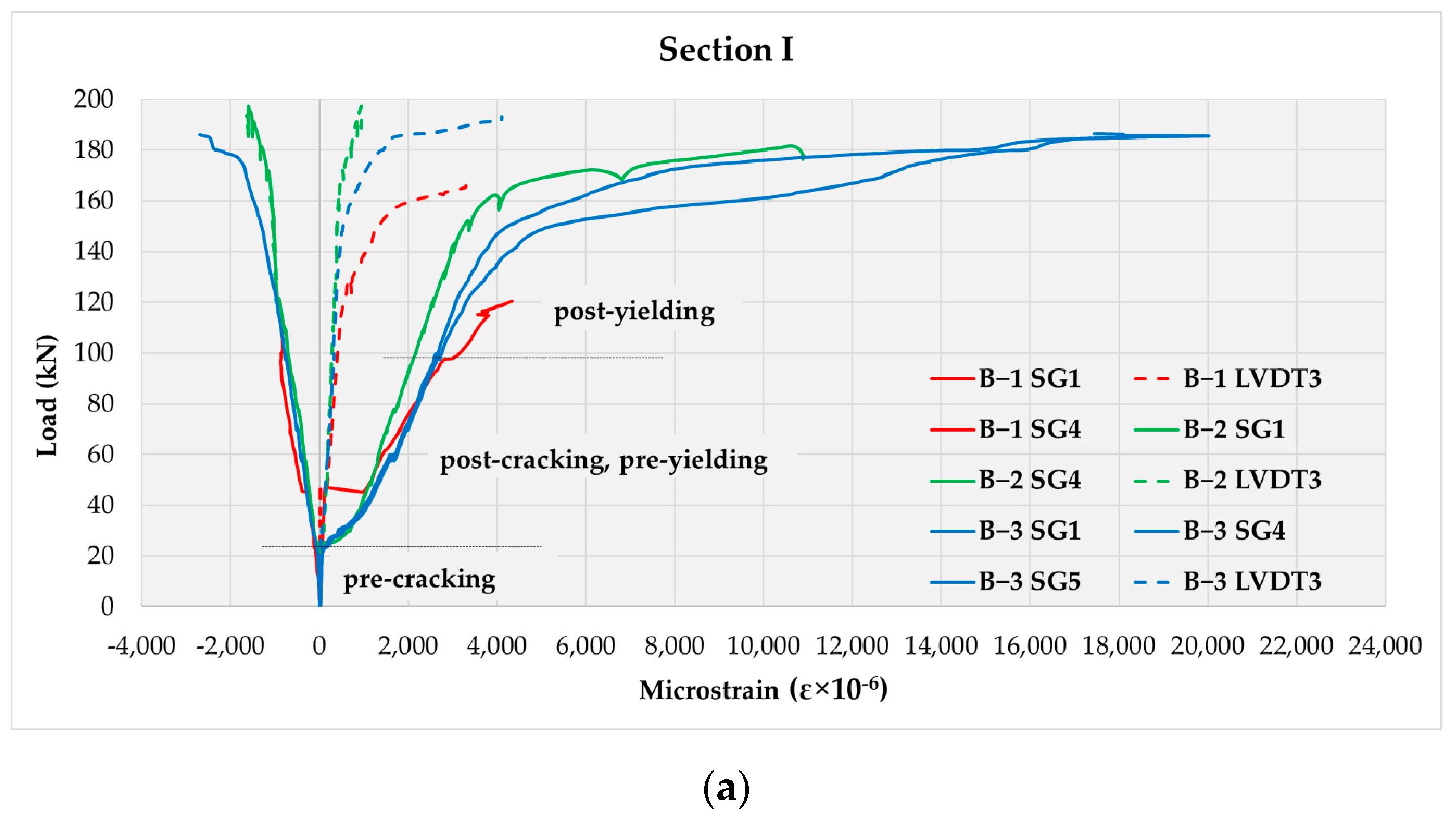
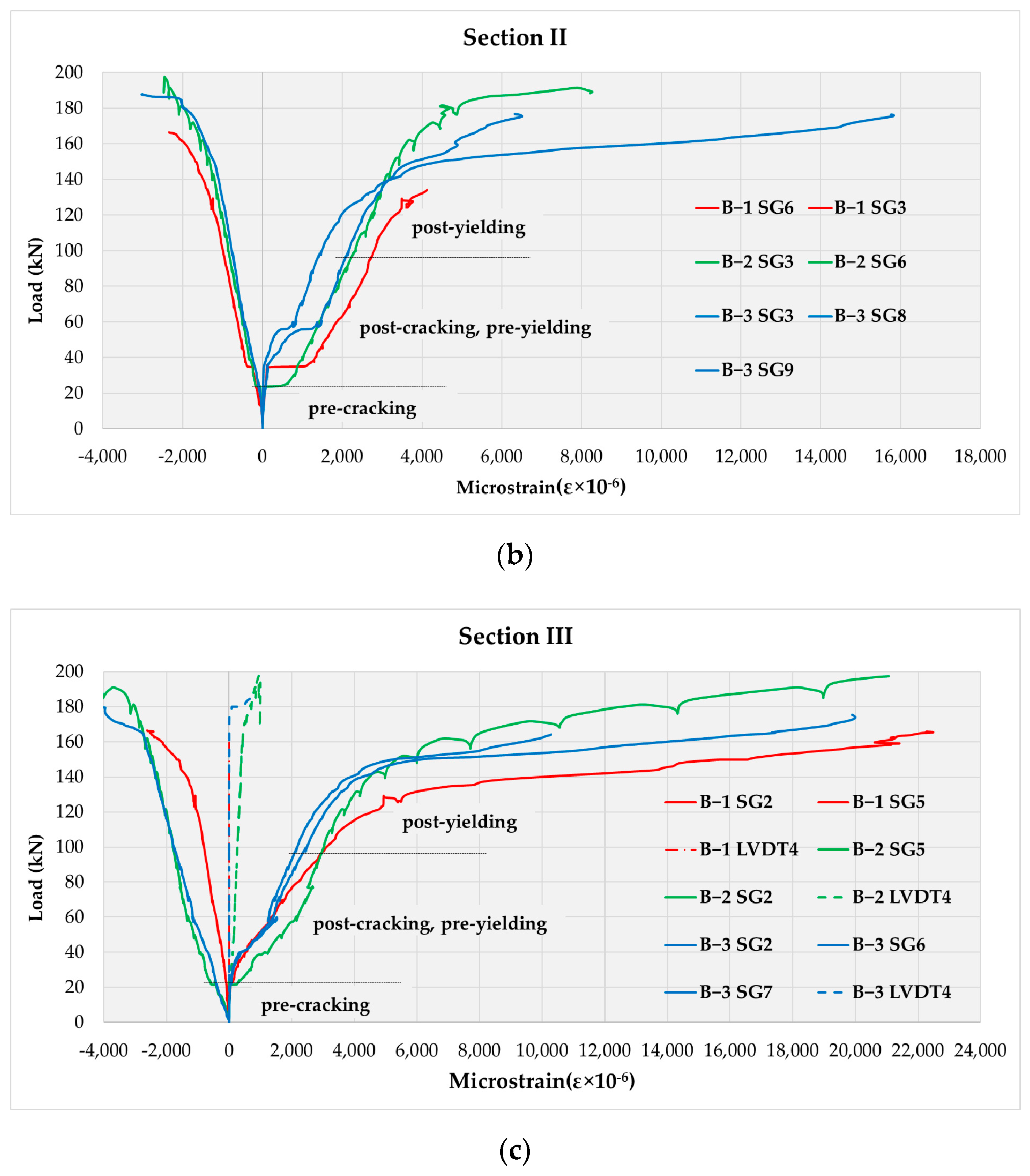
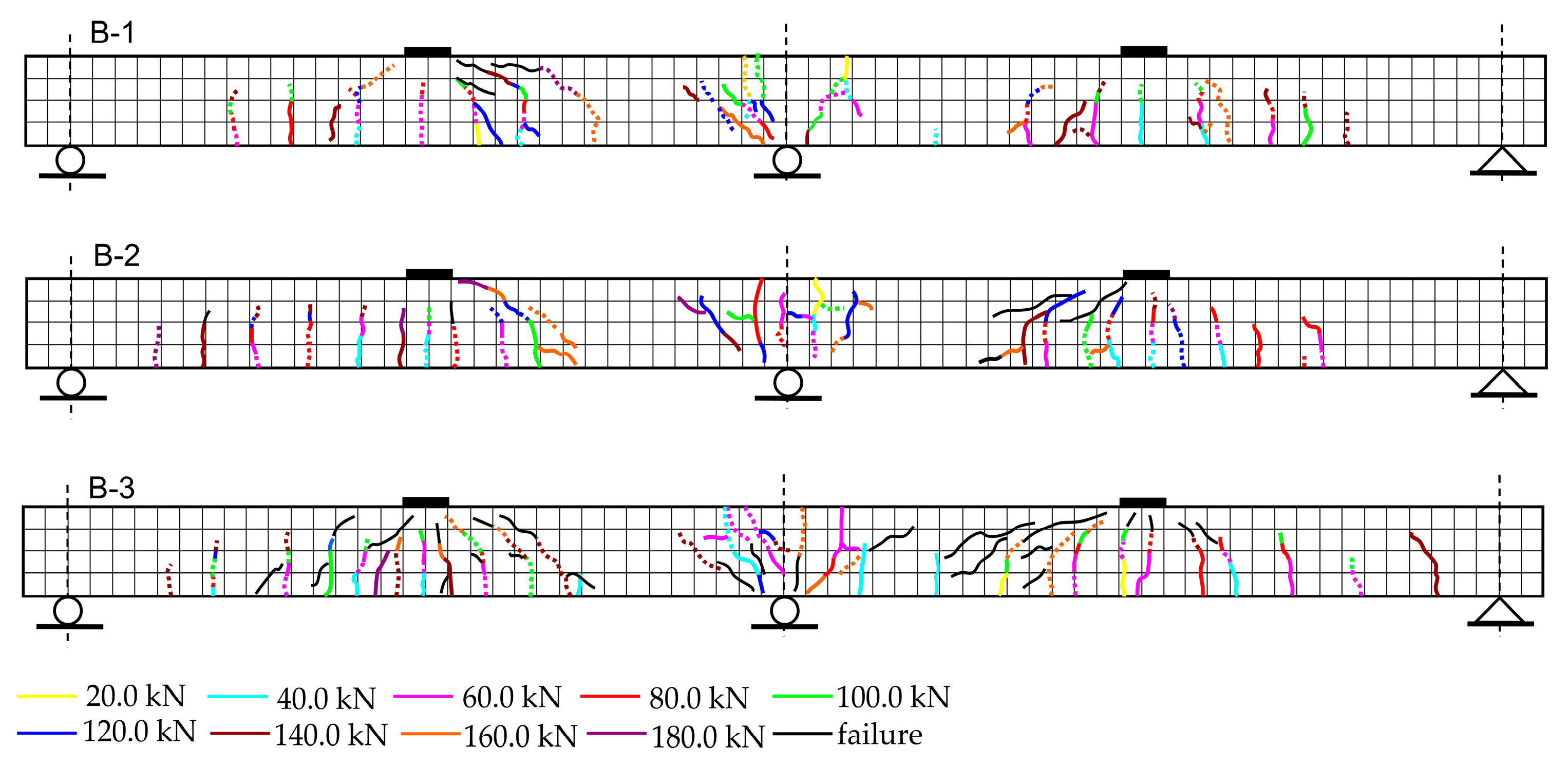
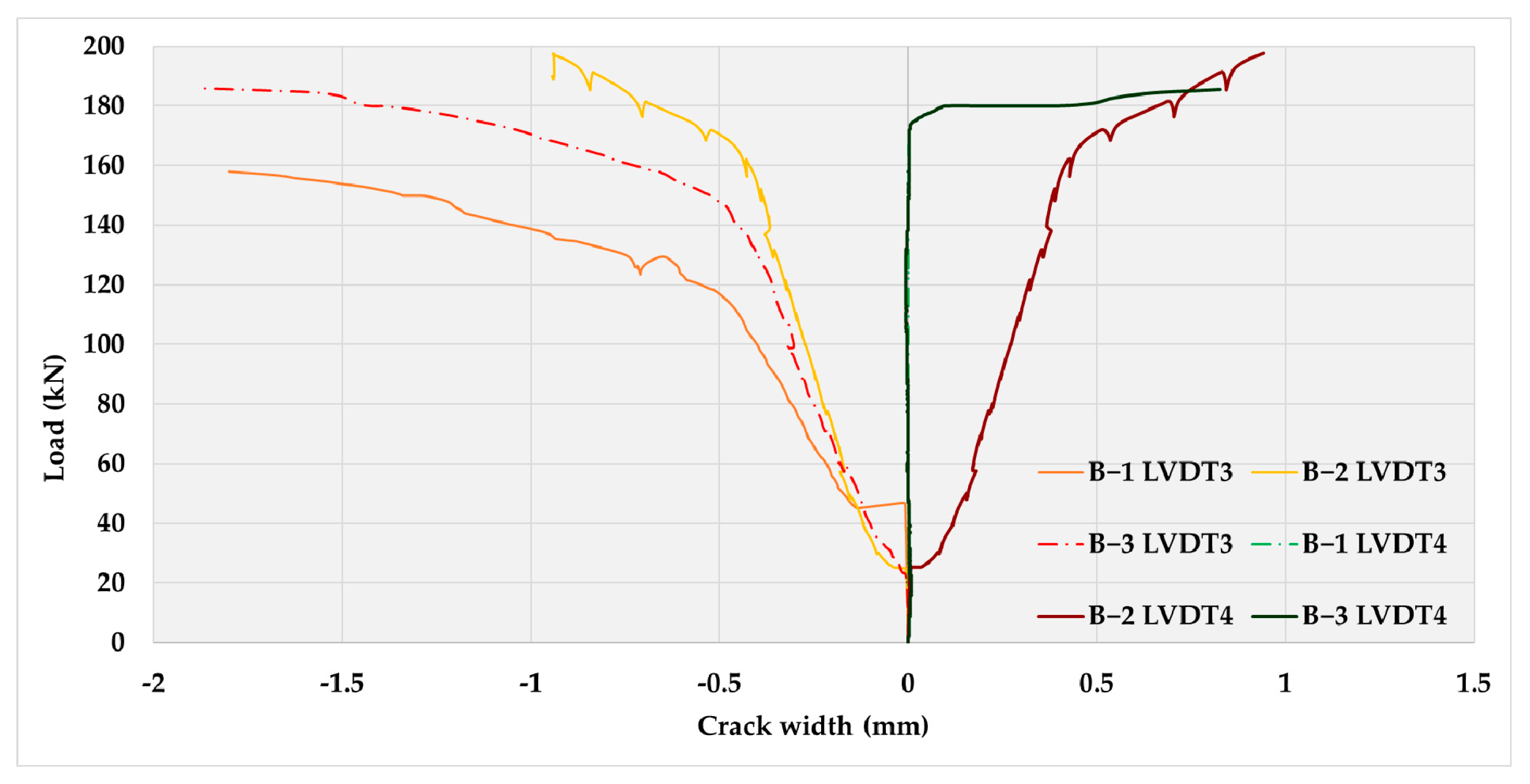
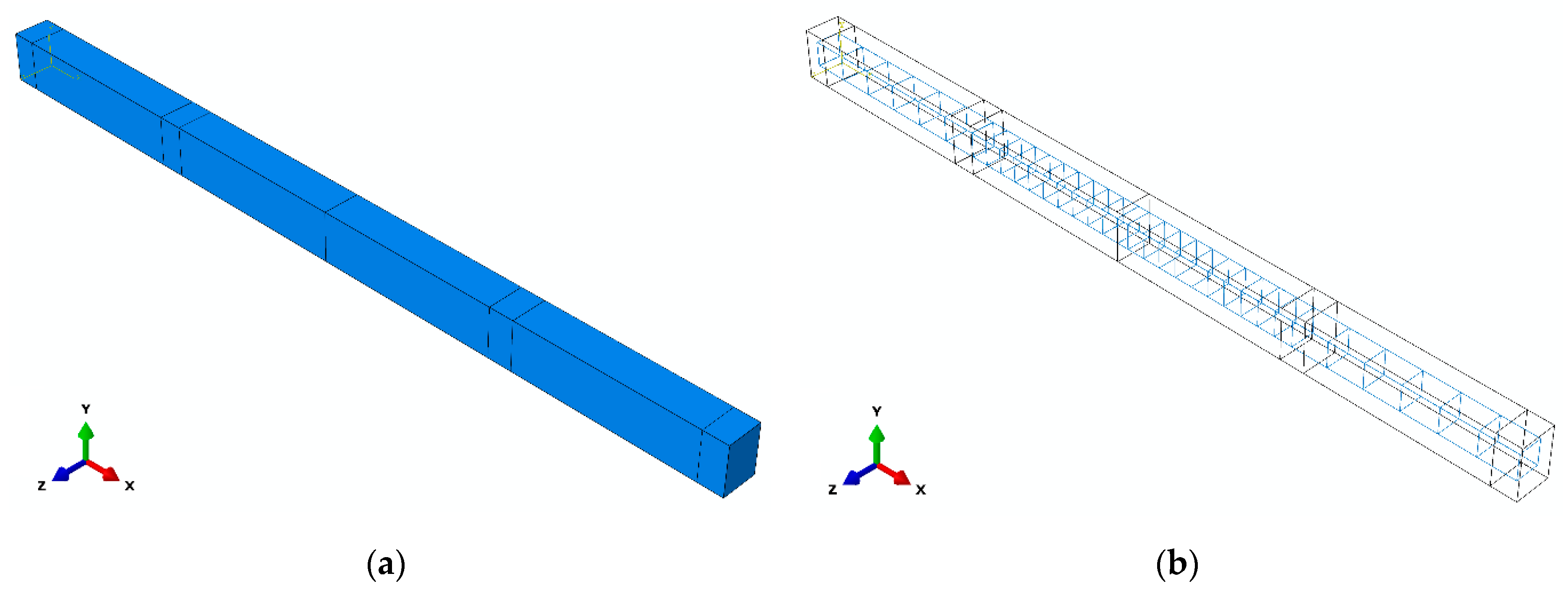
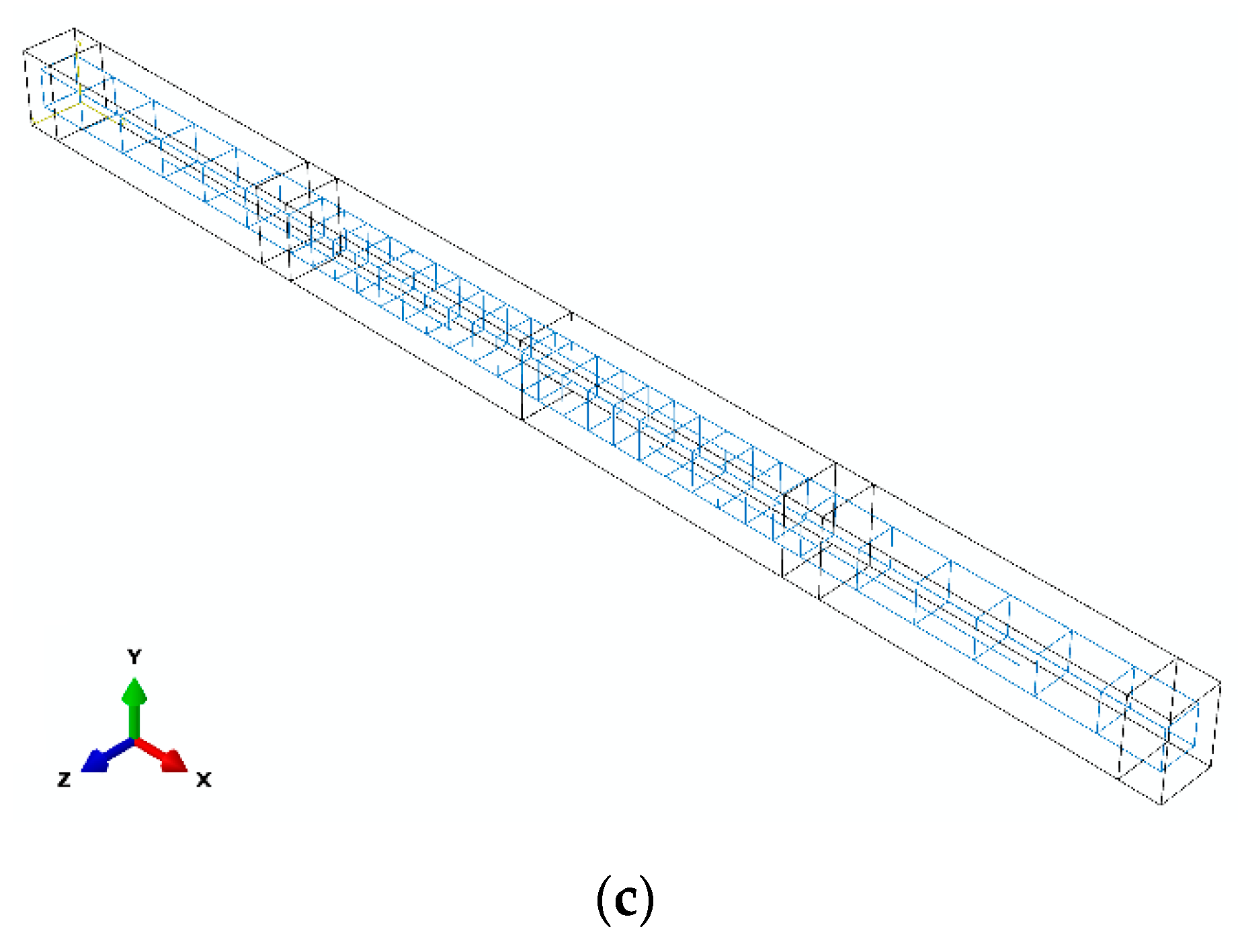
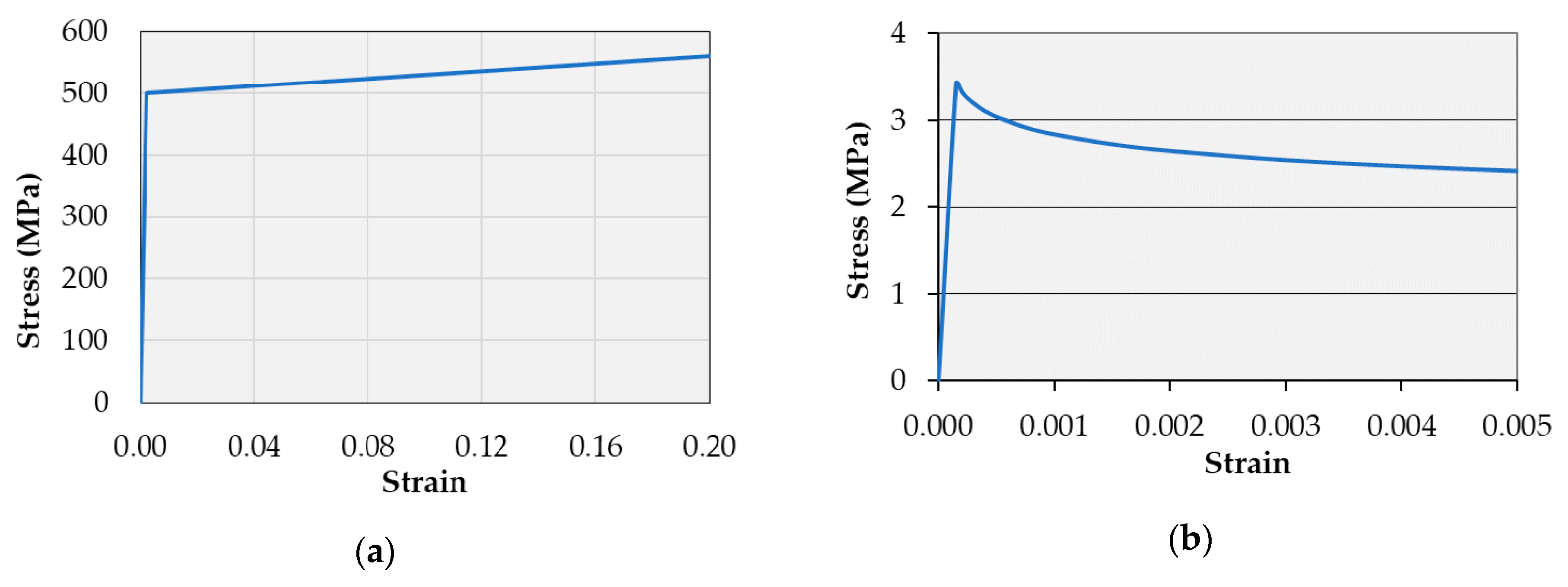
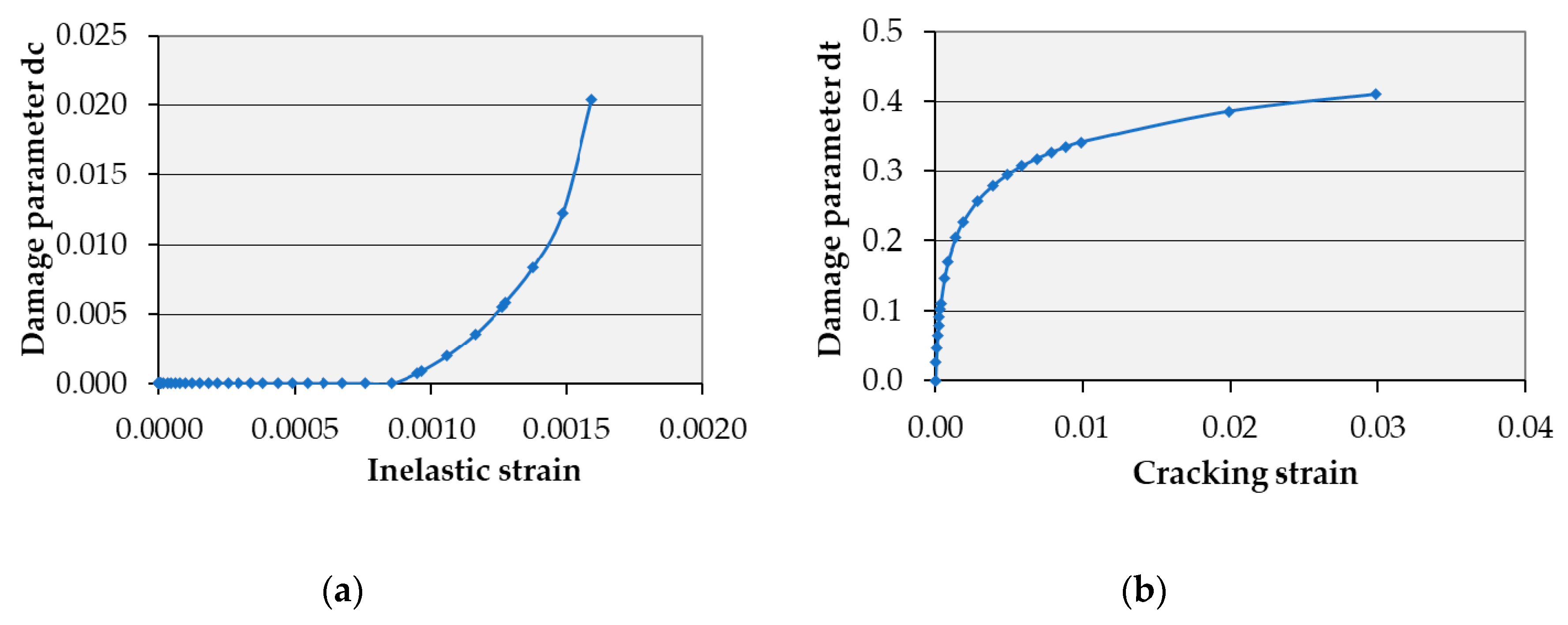

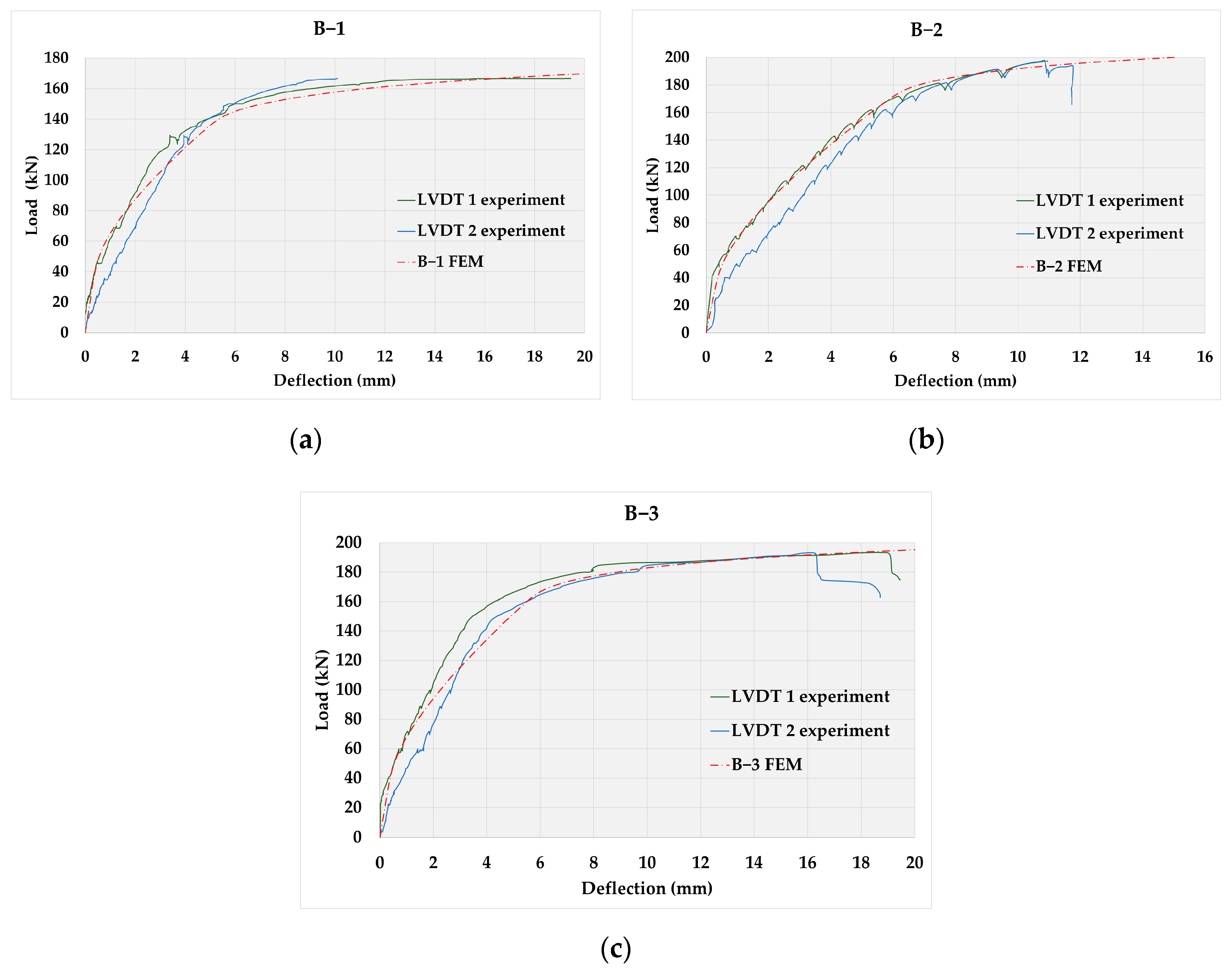
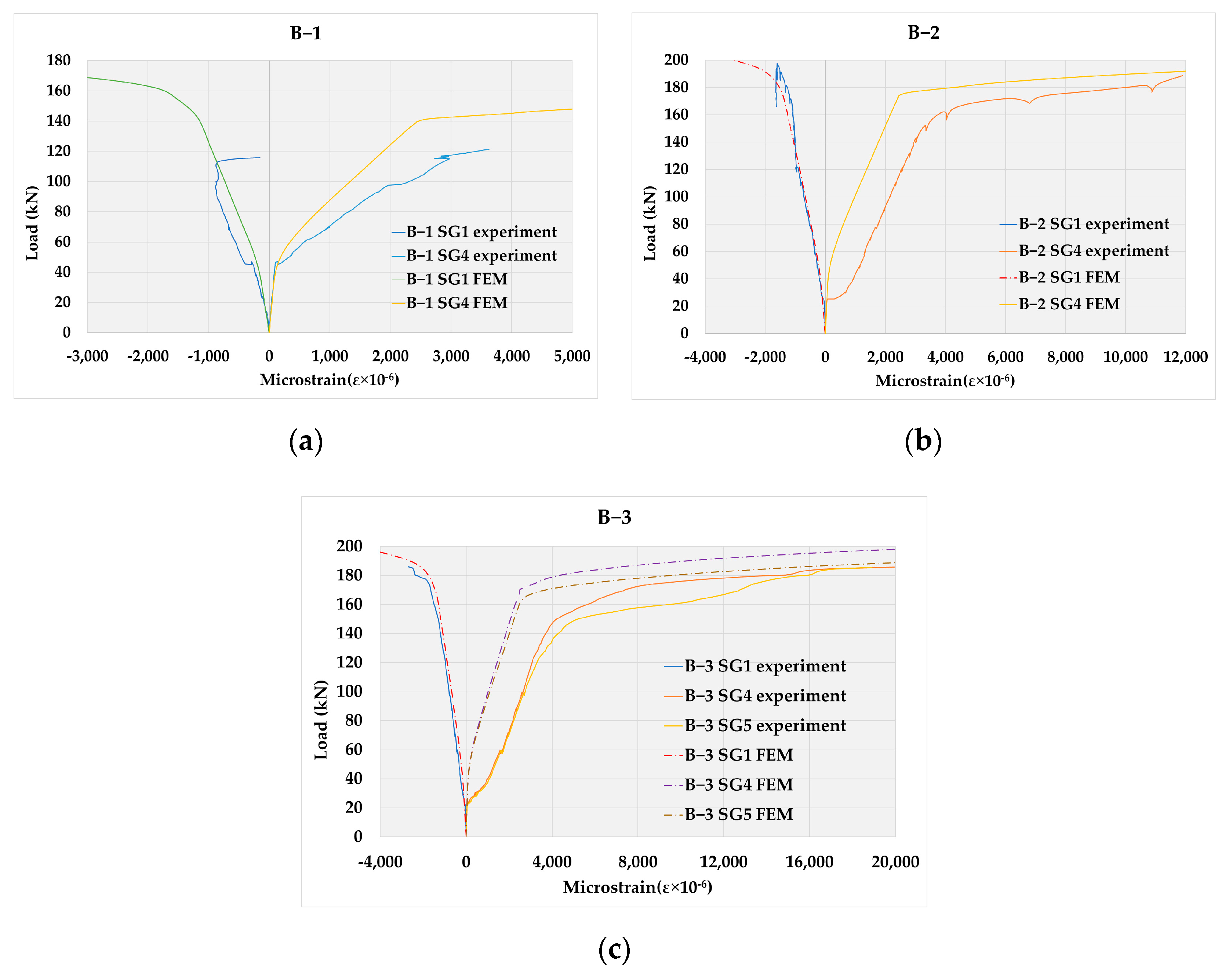
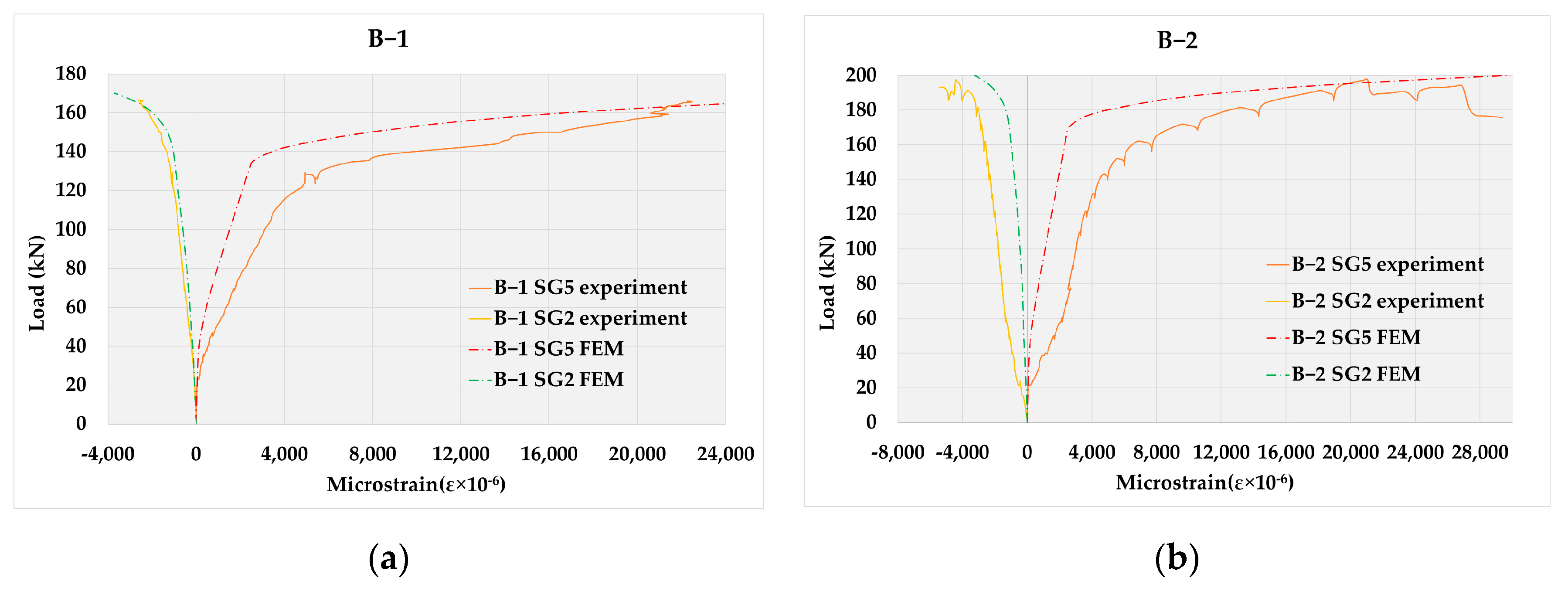
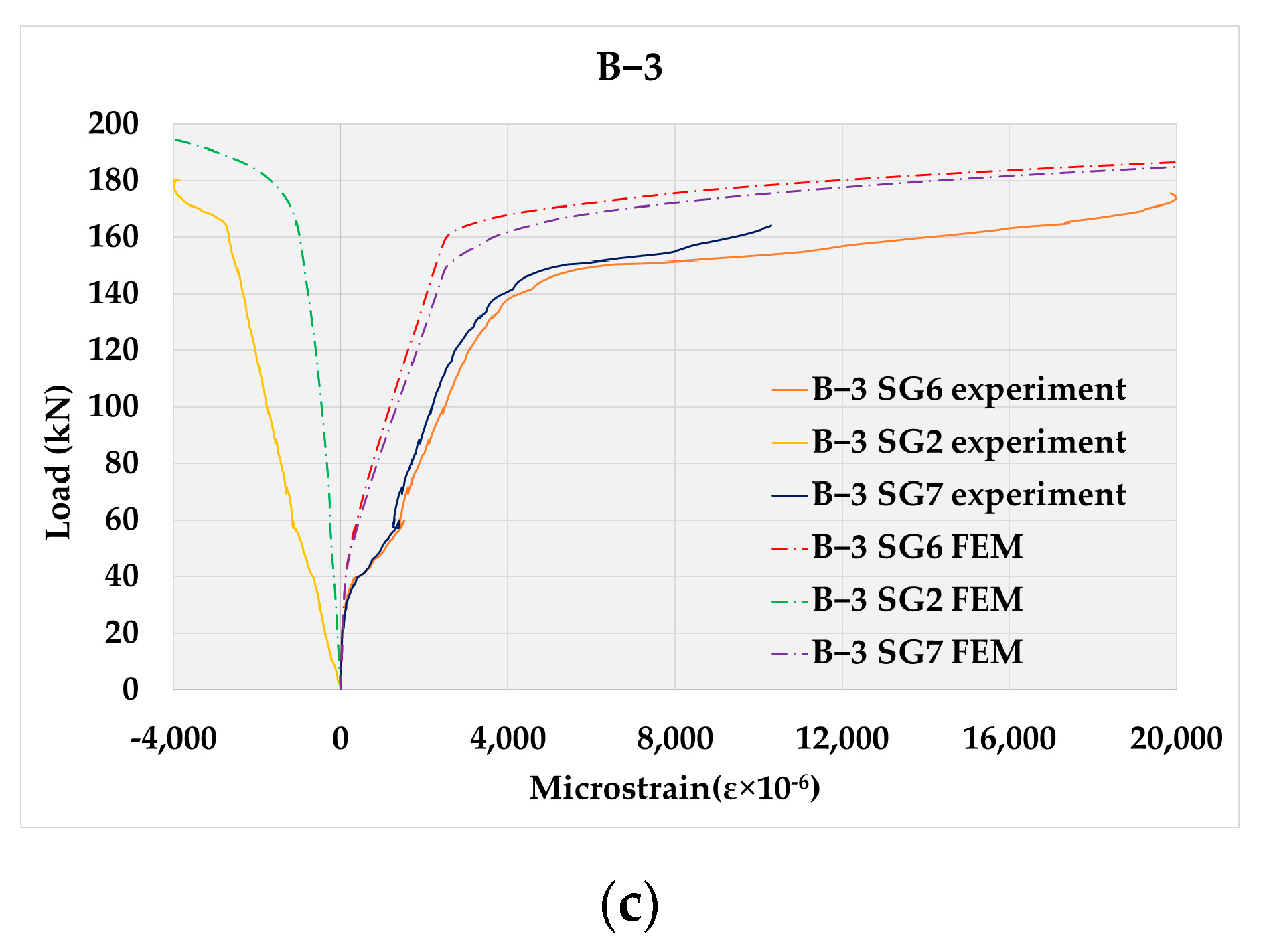
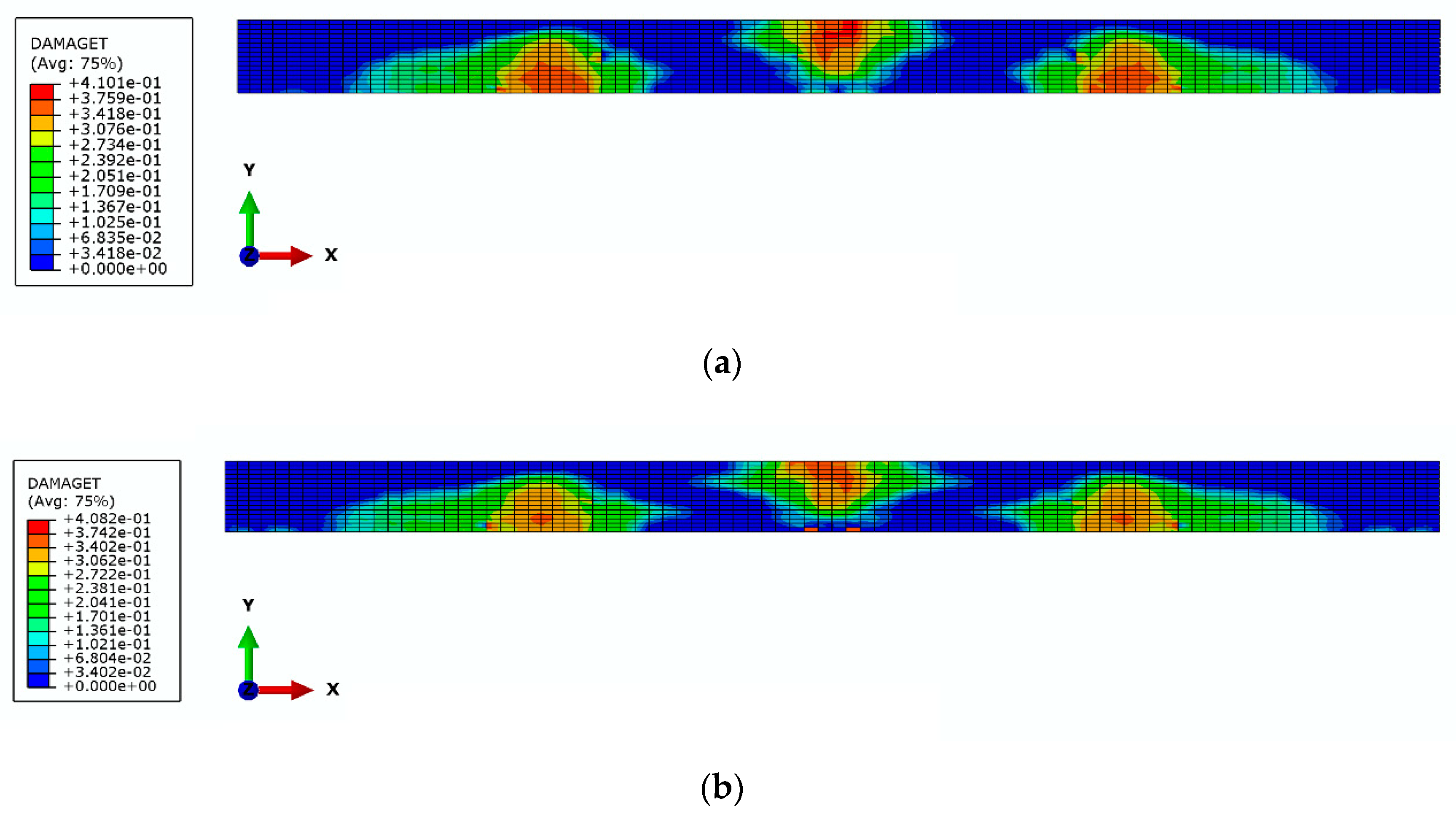

| Setting Time, Min | Start 176, End 226 |
|---|---|
| Density | 3.13 g/cm3 |
| Bulk density in loose state | 930 kg/m3 |
| Bulk density in compacted state | 1515 kg/m3 |
| Tensile strength at 2 days | 6.98 N/mm2 |
| Tensile strength at 28 days | 9.30 N/mm2 |
| Compressive strength at 2 days | 31.33 N/mm2 |
| Compressive strength at 28 days | 55.15 N/mm2 |
| Mass for 1 m3 (kg) | ||
|---|---|---|
| limestone filler | 100.0 | |
| cement | 430.0 | water absorption (%) |
| fraction 0–4 mm | 807.5 | 0.80 |
| fraction 4–8 mm | 380.0 | 0.50 |
| fraction 8–16 mm | 553.0 | 0.40 |
| water | 210.0 | |
| MC Power Flow 1102 additive | 2.2 |
| Density (kg/m3) | Slump-Flow Test D (mm) | t500 (s) | ωc (Water Cement Ratio) |
|---|---|---|---|
| 2305 | 605 | 4.8 | 0.49 |
| Density (kg/m3) | Compressive Strength (MPa) | Tensile Strength (MPa) | Modulus of Elasticity (GPa) | |||||
|---|---|---|---|---|---|---|---|---|
| Secant | Tangent | |||||||
| ρ | fc,2 | fc,7 | fc,14 | fc,28 | fck | fct,28 | Ec | Ecm |
| 2325 | 20.40 | 30.75 | 42.45 | 46.55 | 48.60 | 3.80 | 26.12 | 25.55 |
| Standard deviation (σ) | 1.07 | 2.07 | 2.36 | 0.92 | 1.41 | 0.21 | 1.91 | 1.87 |
| Beam Label | Principal Reinforcement (1) | Additional Reinforcement (2) | Reinforcement Percentage |
|---|---|---|---|
| B−1 | ±2B ∅10 | / | 0.65 |
| B−2 | ±2B ∅12 | / | 0.94 |
| B−3 | ±2B ∅10 | ±1B∅8 | 0.86 |
| Beam Label | Tensioned Steel Reinforcement | Compressed Concrete | Tensioned Concrete | Deflection | |
|---|---|---|---|---|---|
| B−1 | SG4 | SG1 | LVDT3 | LVDT1 | |
| Section I | B−2 | SG4 | SG1 | LVDT3 | LVDT1 |
| B−3 | SG4, SG5 | SG1 | LVDT3 | LVDT1 | |
| B−1 | SG6 | SG3 | - | - | |
| Section III | B−2 | SG6 | SG3 | - | - |
| B−3 | SG8, SG9 | SG3 | - | - | |
| B−1 | SG5 | SG2 | LVDT4 | LVDT2 | |
| Section II | B−2 | SG5 | SG2 | LVDT4 | LVDT2 |
| B−3 | SG6, SG7 | SG2 | LVDT4 | LVDT2 |
Publisher’s Note: MDPI stays neutral with regard to jurisdictional claims in published maps and institutional affiliations. |
© 2020 by the authors. Licensee MDPI, Basel, Switzerland. This article is an open access article distributed under the terms and conditions of the Creative Commons Attribution (CC BY) license (http://creativecommons.org/licenses/by/4.0/).
Share and Cite
Petrović, Ž.; Milošević, B.; Zorić, A.; Ranković, S.; Mladenović, B.; Zlatkov, D. Flexural Behavior of Continuous Beams Made of Self-Compacting Concrete (SCC)—Experimental and Numerical Analysis. Appl. Sci. 2020, 10, 8654. https://doi.org/10.3390/app10238654
Petrović Ž, Milošević B, Zorić A, Ranković S, Mladenović B, Zlatkov D. Flexural Behavior of Continuous Beams Made of Self-Compacting Concrete (SCC)—Experimental and Numerical Analysis. Applied Sciences. 2020; 10(23):8654. https://doi.org/10.3390/app10238654
Chicago/Turabian StylePetrović, Žarko, Bojan Milošević, Andrija Zorić, Slobodan Ranković, Biljana Mladenović, and Dragan Zlatkov. 2020. "Flexural Behavior of Continuous Beams Made of Self-Compacting Concrete (SCC)—Experimental and Numerical Analysis" Applied Sciences 10, no. 23: 8654. https://doi.org/10.3390/app10238654
APA StylePetrović, Ž., Milošević, B., Zorić, A., Ranković, S., Mladenović, B., & Zlatkov, D. (2020). Flexural Behavior of Continuous Beams Made of Self-Compacting Concrete (SCC)—Experimental and Numerical Analysis. Applied Sciences, 10(23), 8654. https://doi.org/10.3390/app10238654









